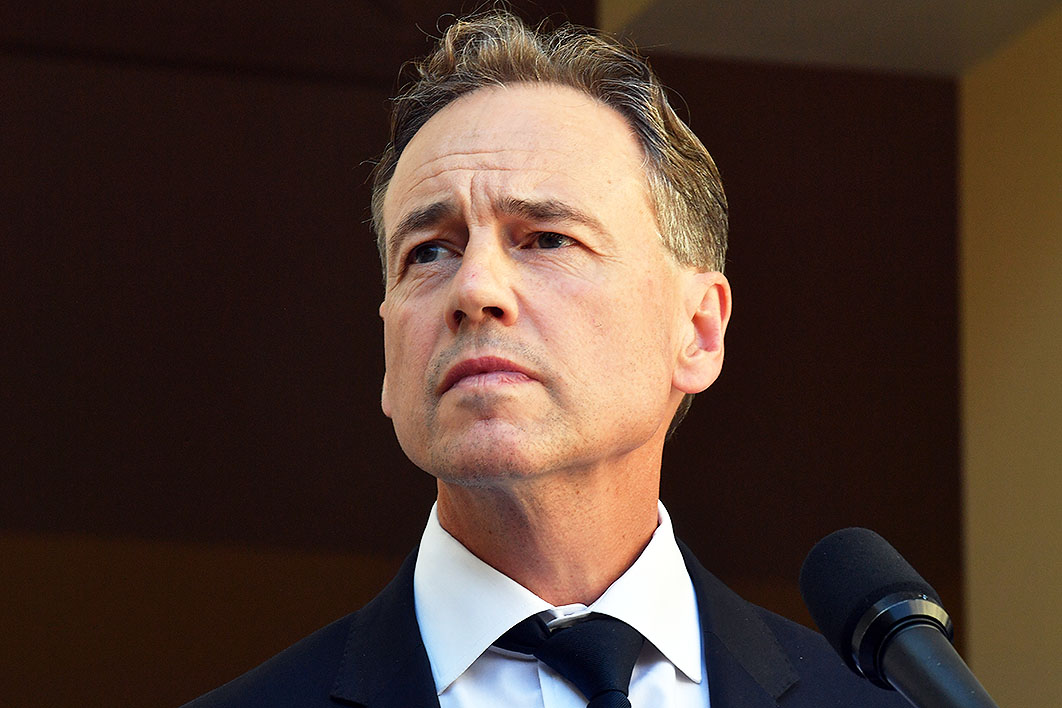Back in the late 1920s a young woman named Phyllis Forster finished her course at the Victorian College of Pharmacy and enlisted as one of Australia’s first female trainee pharmacists. Phyllis Foster eventually became Phyllis Grant and had a daughter, Kathinka, who happens to be Greg Hunt’s mother. Perhaps it’s no surprise that Australia’s health minister has always been a strong supporter of pharmacy.
But supporting the pharmacy profession need not mean supporting the business interests of retail pharmacy owners, especially given a string of reports and inquiries calling for changes to the five-yearly Community Pharmacy Agreements, or CPAs, that spell out how the government supports and regulates the industry.
The latest and most thorough of those reviews was commissioned by Mr Hunt’s predecessor, Sussan Ley, and came up with a detailed blueprint for change. Yet Mr Hunt is on the brink of signing another CPA with the Pharmacy Guild of Australia, which represents pharmacy owners, without having signalled any basic change in approach. Unless he significantly revises the terms of the CPA he will be committing the government to another five years of restricted competition and stifled innovation after the current agreement expires on 30 June.
The CPAs come with a big price tag for the federal government. The six since 1990 have committed the government to spending a sizeable chunk of its total health budget — in the case of the current agreement, $18.9 billion over five years — on pharmacy. This funding comprises $15.5 billion from the Commonwealth and $3.4 billion from patient contributions for the supply of PBS medicines and related programs, such as home medicine reviews.
Pharmacy services are vital, of course, but these agreements cover much more than the dispensing of medication. What started in 1990 as an agreement for funding prescription medicines has steadily broadened to include other regulatory matters, including the ownership and location of pharmacies. Controversially, the agreements restrict pharmacy ownership to qualified pharmacists (with a limit of five pharmacies per pharmacist) and prevent new pharmacies from opening within a certain distance of an existing pharmacy (usually 1.5 kilometres in cities and ten kilometres in regional areas). They also prohibit pharmacies from operating within or being directly accessible from supermarkets.
These are the rules that stop consumers from picking up prescriptions at their local supermarket or getting their scripts filled at their GP’s surgery by an in-house pharmacist. In areas that pharmacists don’t see as economically viable — including many parts of rural and remote Australia — the rules preclude existing healthcare services from running a pharmacy with a pharmacist in charge. For remote communities like Lajamanu in the Northern Territory or Purnululu in Western Australia, where just three pharmacies cover an area around the size of New South Wales, the nearest pharmacy can be eight hours or more away.
Given that these are among the most restrictive rules in any industry in Australia, it’s not surprising that a series of inquiries and reviews have called for them to be loosened. In 2014, for instance, the National Commission of Audit argued for “opening up the pharmacy sector to competition, including through the deregulation of ownership and location rules.” The following year, the Competition Policy Review declared community pharmacy to be one of the priority areas for “immediate reform action.” In 2018, a Senate committee recommended that the government “enhance competition in the delivery of pharmaceuticals listed on the Pharmaceutical Benefits Scheme, with priority given to consumers rather than pharmacy owners.”
Consumer groups and other health organisations have also called for change. The Consumers Health Forum of Australia argues that government support for community pharmacies should be “more transparent and contestable,” and the location rules should “be removed to allow for competition, innovation and new pharmacies.” The Grattan Institute recommends “cautious” removal of the ownership rules: “Like the location rules, these appear much more effective in protecting the commercial interests of pharmacy owners than in serving the public interest.”
The medical profession seems to agree. Harry Nespolon, president of the Royal Australian College of GPs, wrote last year that “the current laws are anti-competitive, without any benefits to consumers.” His words were echoed not long after by Australian Medical Association president Tony Bartone. And earlier this year the Australian Healthcare and Hospitals Association declared that the restrictions “should be subject to an independent, rigorous and transparent public interest test.”
The Pharmacy Guild’s position is that ownership and location restrictions are necessary to ensure quality, safety and accessibility. But the official inquiries have agreed that location restrictions aren’t necessary to guarantee a reasonable distribution of pharmacies in most areas of Australia. And they have pointed out that restricting ownership of a pharmacy to a qualified pharmacist makes no sense when many pharmacy owners don’t themselves work in their pharmacies, instead employing other pharmacists to provide services.
Brands like Chemist Warehouse and Priceline, which operate under franchise (or similar) arrangements linking individual pharmacies under a single brand, also undermine the Guild’s argument against the involvement of other parties, such as supermarkets, in retail pharmacy.
Part of the challenge for governments is that retail pharmacies are a health service wrapped up in a small business. Governments clearly have an interest in funding the supply of PBS medicines, and this may require some support for retail pharmacy infrastructure. But it seems clear that this support shouldn’t extend further than is necessary to ensure a reliable and high-quality supply of medicines.
An important role of the CPA is to set a fair price for dispensing PBS medicines, and to do this governments need access to accurate information about the costs of providing this service. But separating the health-related activities of retail pharmacies from their sale of cosmetics, perfume and other products can be difficult. The Guild has resisted attempts to obtain independent financial data from the sector, leaving the government largely reliant on the information provided by the Guild. With Australians filling around 300 million prescriptions each year, even a small overestimate in the cost per prescription can mean a large outlay for government and a windfall for pharmacy owners.
The widely recognised flaws in the CPAs don’t end there. Adding to the policy black hole is the lack of any independent oversight: the agreements are struck in secret, and no impartial body has the job of making sure they’re honoured.
It’s true that an agreement consultative committee oversees payments to pharmacists, making sure they meet their community service obligations and checking that the rules governing location and electronic prescriptions are observed. But four of its members are nominated by the Pharmacy Guild and four by the health department, leaving consumer interests, doctors’ groups and other experts entirely out of the picture.
When the fifth CPA was evaluated back in 2015 by an external team — itself a first — its governance and administrative arrangements were found to be out of step with normal public sector principles of contestability, transparency and independence. Among interest groups, only the Guild believed that the consultative committee was as representative as required, the evaluation reported. “Many stakeholders” believed that, at a minimum, the committee should include representatives of state and territory governments, the Pharmaceutical Society of Australia and consumer organisations.
In the same year, an Australian National Audit Office report found that the fifth CPA’s evaluation framework made no provision for reviews of the agreement’s two major financial components: pharmacy remuneration and community service obligation payments to pharmaceutical wholesalers. Pharmacy remuneration, which accounts for around 90 per cent of funding under the fifth CPA, “has not been fully reviewed since 1989.”
The Audit Office report is scathing about the health department’s administration of the fifth CPA. “Shortcomings in Health’s performance reporting and fifth CPA evaluation framework mean that the department is not well positioned to assess whether the Commonwealth is receiving value for money from the agreement overall, or performance against its six principles and objectives.” As a result, “there is no ready basis for the Parliament or other stakeholders to determine the actual cost of pharmacy remuneration delivered under the fifth CPA.”
Despite this finding, reporting on expenditure under the sixth CPA is still inadequate, with the relevant page on the health department’s website not having been updated since December 2015.
The range of criticisms from different bodies might explain why the government hasn’t yet acted, if not for the fact that it already has the blueprint for reform written by the independent high-level panel appointed by Sussan Ley.
The panel was chaired by economist Stephen King, a commissioner with the Productivity Commission, and its other members were Jo Watson, an experienced consumer advocate, and Bill Scott, a pharmacist and pharmacy owner and former president of the Pharmacy Guild. It was Australia’s most comprehensive review of the pharmacy sector and possibly the most extensive review ever of any sector of the health system.
A series of meetings with peak health consumer, pharmacy and industry bodies led to a discussion paper that generated over 500 written submissions. A series of public forums in cities and regional areas culminated in a live national webcast. An interim report in June 2017 generated another 201 submissions, with the peak bodies also giving feedback. Six commissioned research reports fed into the process.
In its final report in September 2017, the panel proposed a twenty-year plan to create a “consumer-centred, integrated and sustainable community pharmacy sector which is adaptive to the inevitable changes in healthcare given Australia’s ageing population, rapid advances in technology and ongoing PBS [Pharmaceutical Benefits Scheme] reform.” Forty-one of its recommendations were a consensus view of all three panel members, with two versions of the remaining three recommendations provided, one version supported by Professor King and Ms Watson and the other by Mr Scott.
Central to the review’s recommendations is the removal of ownership and location restrictions. In line with the findings from previous inquiries, the review found that the current restrictions reduce competition and allow monopolies or virtual monopolies to exist in local areas, resulting in higher prices, less variety, lower-quality service (reduced opening hours, for instance) and increased travel costs. It also recommended an end to the ban on pharmacies being accessible from within a supermarket.
The review echoed concerns about a lack of transparency and accountability in the administration of CPAs, recommending that future agreements concentrate primarily on dispensing services and include other stakeholders, specifically the Consumers Health Forum of Australia and the Pharmaceutical Society, the professional body for pharmacists.
Other recommendations included the development of an easily accessible and searchable atlas of all community pharmacies in Australia and the possible creation of a twenty-four-hour hotline to provide pharmacist advice and medicines information to consumers. Restrictions on the Aboriginal Health Service’s owning and operating a pharmacy at its own premises would be lifted. Machine dispensing would be trialled in a small number of secure locations not currently served by a community pharmacy. Homeopathic products would not be sold.
And the government’s response? In May 2018 it announced its support for just four of the forty-four recommendations. A further four were “accepted in principle,” three were rejected outright, and the remaining thirty-four were simply noted.
None of the recommendations accepted by the government involve significant policy changes or are at all contentious. Recommendation 2.5, for example, suggests that medicine information should be made available to consumers, and recommendation 6.3 states that pharmacy programs funding under the CPA should be based on evidence and deliver good value. All of the recommendations covering more substantial and controversial reform issues — including the location and ownership restrictions and the scope of the CPA — were left in limbo.
Lobbying by the Pharmacy Guild is certainly one important reason for the government’s noncommittal reaction. The low-profile Guild, a significant donor to both Labor and the Coalition, is one of the most powerful and successful lobby groups in Canberra. (In 2018–19 it was the largest political donor from the health sector and the sixth-largest overall.)
Commentators from both sides of politics have raised concerns about the Guild’s political influence. Former Liberal adviser Terry Barnes describes it as “superbly resourced and staffed, supported by its highly disciplined membership of pharmacy proprietors, and [with] a fearsome reputation for mobilising voters to support its campaigns.” Former Labor adviser Lesley Russell says that “pharmacies have a unique ability to garner public support for their causes from loyal customers.” Former Australian Competition and Consumer Commission chair Graeme Samuel has described the Guild’s lobbying tactics as “political blackmail” and argued that “they’re the most powerful union in Australia.”
Greg Hunt took on the Guild when he tightened up the sale of codeine, a move that the Guild opposed. A recent study found that this decision halved the number of codeine poisonings in Australia. But the minister allegedly backed down from a plan to allow prescriptions to cover a longer period (on doctors’ advice) after lobbying by the Guild. Longer prescriptions would enable consumers to minimise the number of pharmacy visits (especially important for people in rural areas, older people and those with disabilities) but would affect pharmacies’ bottom line by reducing dispensing fees and customer visits.
It’s important to remember that the Guild only represents owner-pharmacists, which means younger pharmacists are excluded from any say, direct or indirect, in the CPAs. Not surprisingly, the ownership and location regulations benefit existing owners but disadvantage new entrants. In fact, Stephen King and his panel found that employee pharmacists often face poor remuneration and uncertain career paths because of the anti-competitive nature of the retail pharmacy market.
Greg Hunt has not publicly revealed his intentions for the seventh CPA, and negotiations have, as usual, been conducted behind closed doors. But the process has changed in two ways this time round. For the first time, the Pharmaceutical Society of Australia (the professional body for pharmacists) will join the Guild as a cosignatory; and the government has held two round tables with a broad range of stakeholders to discuss issues relevant to the seventh CPA.
Whether these changes are merely cosmetic or rather will result in an agreement that better serves the health needs of the community remains to be seen. Given that the recommendations made by King and his panel generated wide support — even from some inside the pharmacy industry — Mr Hunt should have the confidence to act in the interests of the community rather than the Guild without significant political damage, and indeed with wide support in the health sector and the broader community.
Reform would also help provide a more secure future for the profession by opening up opportunities for younger pharmacists. It would create a more responsive environment in which the profession can evolve and change to meet the needs of the community, for example by expanding the role of pharmacists in providing immunisations, screening services and other healthcare directly to consumers.
Undoing three decades of policies and regulations is never easy, but the Covid-19 pandemic has demonstrated how major changes within the health system are possible and can even happen quite quickly.
Greg Hunt’s response to the King review also has broader implications. If he ignores the overwhelming evidence on the need for reform of the pharmacy sector, he will undermine the government’s credibility in other health policy areas. He will also reduce the motivation for stakeholder groups to commit the substantial resources required to participate in future inquiries and weaken these potentially powerful tools for policymaking. •
The researching and writing of this article was supported by a grant from the Judith Neilson Institute for Journalism and Ideas.





